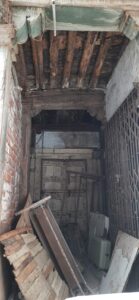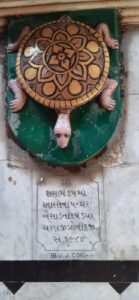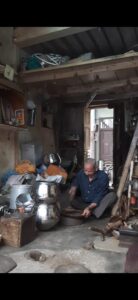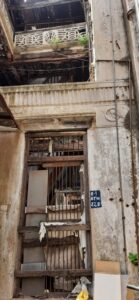When you say Pratap Madgha ni Pol, the first thing that would come to a Barodian’s mind would be; the Ganpati. Reach at the regal Lehripura Gate and stroll through the busy lane of Mangal Bazaar, just take the first right and you will be illumined of the vibrant lighting in the shops. This is the famous Pratap Madgha ni Pol. This pol houses a school which belongs to the pre- independence era. Pol ni Varta explores Pratap Madgha ni Pol which has historical relevance.
Etymology
An interesting story revolves around the nomenclature of this pol. “We belong to one of those four communities whose native is Rajasthan,” informs Jay Thakur. He is the heir belonging to the seventh generation of the family which had transcended from Rajasthan during the Gaekwad period. Initially, the male members of their family used to deliver posts. So, they were the postmen (also known as ‘tapali’ in Gujarati).

The members were diligent and putting in a lot of effort in fulfilling their responsibilities by delivering posts and parcels on time. This was the time of limited means of transportation. Gaekwad noted the hard work of these ‘tapalis’ who travelled on camels day and night and gave them the title of ‘Thakur’. Among all, Pratapsingh Thakor was then the senior most person residing in the locality and performing the task assiduously. Hence, the pol was named behind this responsible man.
One of the most unique aspect of this pol is its square area and plan. If you happen to measure the exact area of this pol, it would make a perfect square which is very unusual. It used to have a ‘chali’ named as ‘Chimanlal ni Chali’ where over 25 families used to reside which is now demolished. The three major attractions of this pol are the Hatkeshwar Mahadev Temple, Rannchhodji Temple and the N. T. Patwa Memorial School.
Exploring the story of temples and school
Hatkeshwar Mahadev Temple

Enter this temple and you will be blessed to see the relief of 12 jyotirlingas on the ceiling. “We are not sure of the exact date of this temple, but it is was first built in the pre- Gaekwad era,” shares Devendra Bhatt, Pandit of the temple. During the time of Gaekwad, ‘Nagar’ Brahmins used to look after this temple which was then passed to the Bhatt family who are ‘Kapodam’ Brahmins.
In the month of Shravan, “Four kamal diyas are offered to Mahadev here along with five lotuses,” tells Ushaben Bhatt who is the daughter- in- law of the Bhatt household. The Bhatt family has five sons and every month, one son and his family takes the charge of this temple. While on the Shravan Ashtami, the Brahmins from the ‘Nagar’ community still visit this temple to offer their puja at the temple.
Rannchhodji nu Mandir
 Vishnu resides in this peaceful shrine, so we can totally imagine the grandeur it would spread in the vicinity. “This temple is also believed to be standing tall since the Gaekwad era. During the month of Shravan or Adhik Maas, this temple is at its creative best by organising hindolas for the entire month,” notifies Vishnuprasad Bhatt who has been the resident of this pol since past 70 years.
Vishnu resides in this peaceful shrine, so we can totally imagine the grandeur it would spread in the vicinity. “This temple is also believed to be standing tall since the Gaekwad era. During the month of Shravan or Adhik Maas, this temple is at its creative best by organising hindolas for the entire month,” notifies Vishnuprasad Bhatt who has been the resident of this pol since past 70 years.
The temple strictly follows the timings of vaishnava darshan and remains shut for the devotees after the darshans unlike the shivalayas.
N. T. Patwa Memorial School
“I was one of the students from over 350 others who were enrolled here,” shares Sudhir Purohit, a 54 year old pol resident. This school was established in 1928 and offers primary education till eighth standard. It used to fall under the category of government schools, but is now taken over by a trust who look after its functioning. The admitted students have now dropped to 60. “Previously when it was running under the government, every student was served with bread and milk at the school,” says Purohit.
 Right outside the school, Pratap Madgha ni Pol has been organising ‘Sarvajanik Ganeshotsav’ since past 60 years. “I have the pictures of last 59 years, though the Ganeshotsav organised here is older than that,” opines Jay Thakur whose grandfather Niranjan Ambalal Patel is believed to have initiated the Ganeshotsav organised here and has taken it to definite heights. It is one of the pandals which becomes talk of the town during the festivity. The best part about this pandal is that “The businessmen irrespective of the religion that they belong to, be it Muslim or Hindu, fund for the Ganeshotsav,” says Thakur. Who said communal harmony in the city is missing?
Right outside the school, Pratap Madgha ni Pol has been organising ‘Sarvajanik Ganeshotsav’ since past 60 years. “I have the pictures of last 59 years, though the Ganeshotsav organised here is older than that,” opines Jay Thakur whose grandfather Niranjan Ambalal Patel is believed to have initiated the Ganeshotsav organised here and has taken it to definite heights. It is one of the pandals which becomes talk of the town during the festivity. The best part about this pandal is that “The businessmen irrespective of the religion that they belong to, be it Muslim or Hindu, fund for the Ganeshotsav,” says Thakur. Who said communal harmony in the city is missing?
The nostalgic pol residents

People belonging to this pol say that 200 years back the residents of this pol used to practice different professions; mostly linked to the service for the royal family. “Had you walked on this lane a decade ago, you would find paan shops in the entire lane,” shares Purohit. People belonging to the ‘Tamboli’ community used to sell variety of paans. The shops were based at a fix height where the paan maker used to sit on the platform and make paans. Slowly, since the consumption of paan had declined, people started seeking for an alternate business of repairing and a few shifted to selling cups and saucers.
“I was 10 when my yagnopavit took place near the Chimanlal ni Chali,” informs Vishnuprasad Bhatt. This chali was made before independence. People belonging to Raval, Maachi and Rajput community used to reside here. They were usually the owners of a lorry or spread patharas while a few played dholak with others practicing bhusa- patti.

This was the lane where there were many utensil shops cum workshops. “From making ghadas to store water to making ghughras for the bhajan mandal, everything was made in these shops,” shares Rajendra Gopaldas Kansara, utensils shop owner. The major change which he has witnessed over the period of time is the mechanisation of the process of making the utensils. “Deghda, Tambakudi, Nada; name a utensil and we used to make it,” Kansara boasts with pride. The oldest mansion of the pol is also named as the ‘Kansara’ mansion. It shares one of the walls with the fort built during the reign of Gaekwad.
Owners of the very famous Trupti restaurant (based on MG Road) started in the Gaekwad era stay in this pol. “Previously, there was a bus stop near the Lehripura gate where people from Padra used to come to the main city to shop. They used to get down and have breakfast and the Trupti restaurant post which they used to visit Mangal Bazaar,” says Purohit.
There was also another famous food joint in the name of Surti Farsan whose proprietors used to stay in this pol. “Bhopabhai’s methi na gota was popular among the Barodians,” reminisces Purohit. That was the time when the fritters were sold at 4 anna and look at the depleting value of money today!

“We have shifted to Manjalpur 30 years ago to ensure convenience of our growing family,” says Gopalbhai Nagardas Dhodia whose family was living in pol since decades. “My heart still resides in pol,” shares Dhodia who comes and spends his entire day at the pol. With narrow lanes and small houses, one of the stirring aspect of pol is in its big hearted people who help each other in every possible manner. Strength of pol is in its people and their socialisation which is missing in the modern society.





